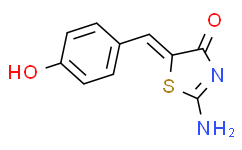| Cas No.: | 1198097-97-0 |
| Chemical Name: | Mirin |
| Synonyms: | Mirin;(Z)-5-(4-hydroxybenzylidene)-2-imino-4-oxo-thiazolidine |
| SMILES: | OC1=CC=C(C=C1)/C=C2C(=O)N=C(N)S/2 |
| Formula: | C10H8N2O2S |
| M.Wt: | 220.247720718384 |
| Purity: | >98% |
| Sotrage: | 2 years -20°C Powder, 2 weeks 4°C in DMSO, 6 months -80°C in DMSO |
| Description: | Mirin is a small-molecule inhibitor of MRN (Mre11, Rad50, and Nbs1) complex.Target: in vitro: Mirin was shown to block Mre11 exonuclease activity and MRN-dependent ATM activation, and to inhibit the ionizing radiation-induced G2/M checkpoint and homologous recombination in mammalian cells. Mirin inhibition of ATM activation is independent of Mre11 nuclease inhibition since the M(HN)RN and M(HL/DV)RN mutant complexes are inhibited equivalently to the wild-type enzyme despite the fact that they are nuclease-deficient. The effects of Mirin have been ascribed to its effects on Mre11 nuclease activity, but as we show here, Mirin is inhibitory of MRN function independent of the nuclease activity of the complex. [2] Addition of the Mre11 inhibitor Mirin to egg extracts and mammalian cells reduces RCC1 association with mitotic chromosomes. HeLa cells expressing Histone H2B-EYFP were treated with Mirin (25 or 50 μM), and mitotic progression was immediately monitored using live cell imaging. Although Mirin-treated cells were able to congress chromosomes to the metaphase plate with similar kinetics as untreated cells, a significant fraction of Mirin-treated cells paused for extended periods of time in a metaphase-like stage without anaphase onset . [1] |
| References: | [1]. Rozier L, et al. The MRN-CtIP pathway is required for metaphase chromosome alignment. Mol Cell. 2013 Mar 28;49(6):1097-107. [2]. Lee JH, et al. Ataxia telangiectasia-mutated (ATM) kinase activity is regulated by ATP-driven conformational changes in the Mre11/Rad50/Nbs1 (MRN) complex. J Biol Chem. 2013 May 3;288(18):12840-51. [3]. Garner KM, et al. Corrected structure of Mirin, a small-molecule inhibitor of the Mre11-Rad50-Nbs1 complex. Nat Chem Biol. 2009 Mar;5(3):129-30. |

 To enhance service speed and avoid tariff delays, we've opened a US warehouse. All US orders ship directly from our US facility.
To enhance service speed and avoid tariff delays, we've opened a US warehouse. All US orders ship directly from our US facility.




















